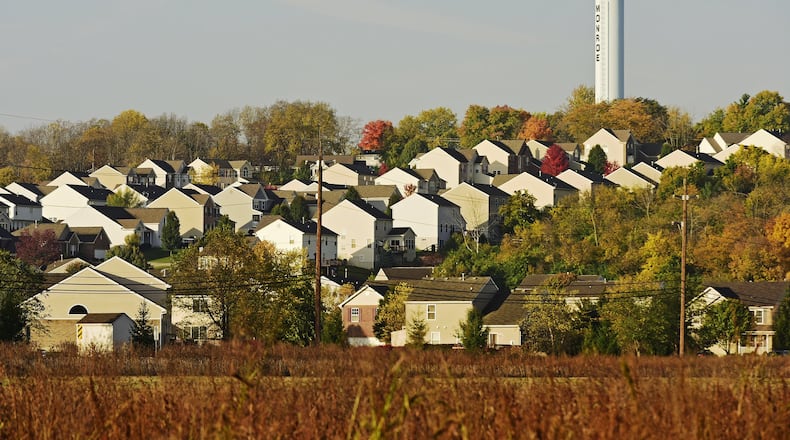Butler County’s Trenton and Warren County’s Mason and Springboro all saw growth of 3 percent or more, while Hamilton, Middletown, Fairfield and Oxford saw modest or no statistically significant changes.
“It really isn’t much of surprise,” Monroe City Manager Bill Brock said of the population growth. “It’s nothing we didn’t anticipate because of the plan we had in place.”
The American Community Survey is the census bureau’s way of providing population and demographic estimates for all communities more frequently than the official census done every 10 years.
The survey puts out 1-year and 5-year estimates annually. The 1-year estimates provide information on communities of 50,000 people or more. The 5-year estimates, which averages data from fives years of surveys, are the only ones that include smaller communities.
The Journal-News looked at the data on 11 area cities in Butler and Warren counties under 50,000 and compared the 2011-2015 5-year estimate to the most recent non-overlapping 5-year period, 2006-2010, to see how much population has shifted.
Of those 11 cities, eight saw population growth while the rest saw modest declines, according to the estimates.
Location is everything
Brock believes the estimated population growth for Monroe is the result of its location on Interstate 75 and its access to Dayton and Cincinnati, its excellent school district, and the affordability of housing in the city.
“The (Monroe Local) schools have done population studies to make sure they are planning their facilities appropriately,” Brock said. “The city also continues to work cooperatively with the school district.”
Monroe’s estimated population is now at 13,666 up from 11,868 reported previous five-year estimate. He said the city is currently planning for the needs of 18,000 to 20,000 residents in the 2020-2025 time frame.
Brock said the city has seen business and industrial growth and is also seeing older neighborhoods with new and younger people moving in. This is in addition to new subdivisions that have been built in the past few years as well as those being planned or under construction. He said the city’s business and industrial growth have been dramatic in the past few years on Monroe’s east side near the Cincinnati Premium Outlet Mall off I-75. Among the new companies that have come to Monroe are IDG, Serta Simmons and UGN.
“We’re in the process of doing a staffing study to make sure the services are there at the levels residents are accustomed to,” he said.
School Superintendent Phil Cagwin said “location” was the reason for the population growth.
“Lakota (Local Schools) is to our south and has expanded their facilities and we’re the next exit north,” he said. “I think it’s a natural progressing of the outgrowth of the urban areas to the north and south. We’re in the middle and we have a nice intersection (I-75 and Ohio 63). We also have a good deal of undeveloped land.”
Cagwin credited Brock and Monroe City Council for being aggressive in it pursuit of companies they believe will be positive additions to the community.
In the past 10 years, student enrollment has grown significantly to 2,804, which is up from 2,126 students in 2006. Cagwin said he expects to re-engage the district’s facilities committee in early 2017 to look at the possibility of a new building.
After a study of the district’s current facilities and projected needs in late 2015, the facilities committee recommended that the Board of Education secure state funding first before moving forward. The last facilities study suggested three options — a new elementary school; build a middle school; or build a new high school. The new building would be built on the school campus on Yankee Road.
Growth despite location challenge
Just across the Great Miami River from Monroe, neighboring Trenton continues to grow despite not being off I-75.
Trenton’s estimated increase of 7.2 percent was the second highest in Butler County, according to the Census survey
Trenton City Manager John Jones said he believes it’s a combination of things. The city’s 5-year estimated population is 12,176, which is up from the previous 5-year estimate of 11,384
“It’s a great place to raise a family and children, has a very good school system and it’s great place to retire,” Jones said.
He said about 90 percent of Trenton’s residents work elsewhere.
“We fall right in the middle of everything (in southwest Ohio),” he said. “Trenton is a small community with lots to offer.”
Jones said not being off I-75 creates challenges that make it difficult to compete with other communities off the interstate.
However, he said the city has plenty of flat ground and a full range of utility services along with a state-certified industrial park.
“We have a lot of places that can be developed,” Jones said.
Larger cities working to foster growth
Butler County’s largest cities of Hamilton, Middletown and Fairfield either saw a modest decrease of less than 1 percent or had no statistically significant changes. Hamilton had estimated population decrease of one-tenth of 1 percent.
Oxford saw a modest increase at 1 percent.
Middletown City Manager Doug Adkins said population size matters as it takes more people to reflect the growth in a larger, urban city than a smaller city.
“I think there are a few different things rolling into those numbers,” he said. “First, give credit to our neighbors in Monroe and Trenton for doing a good job recruiting new families to their city. Second, when comparing size of cities, it takes more residents coming and going in Hamilton and Middletown to reach the same percentage changes seen in the smaller cities.”
Middletown’s 5-year population estimate was reported at 48,563, which is less that the previous 5-year estimate of 48,944.
Adkins said Middletown and Hamilton also have different challenges as urban cities.
“I can’t speak for other cities, but in Middletown, and I suspect in Hamilton as well, much of our efforts the past few years have focused as much on removing blighted housing from our housing stock as it has on recruiting new families to the city.” Adkins said. “Monroe and Trenton did experience the same volume of housing blight as Middletown and Hamilton over the past five years.
Since 2008, Middletown has removed 500 homes from its housing stock, he said.
“For our population to stay flat during the past five years suggests that we successfully added families while simultaneously removing less desirable housing from the city,” Adkins said.
Hamilton City Manager Joshua Smith said the city has aggressively utilized the Moving Ohio Forward funding provided the Ohio Attorney General’s office for the past several years as Middletown has in removing blighted housing from its housing stock.
“… It does not surprise me that we had a negligible decrease in population,” Smith said. “As an older city with little space for new residential development, our population will only increase if we develop denser residential units, primarily in our urban core and in proximity to Miami University-Hamilton.”
The city is currently constructing the $32 million South Hamilton Crossing overpass project that would extend Grand Boulevard to University Boulevard.
In addition to improving safety, officials have said the project will open dozens of acres of greenfield for future development. The project broke ground in August and is expected to be completed in 2018.
Hamilton’s 5-year population estimate is 62,359, which is down from the previous population estimate of 62,466.
Since 2011, the Hamilton Construction Services Office has processed 411 demolition permits that includes public and private demolition projects, according to city records.
About the Author

